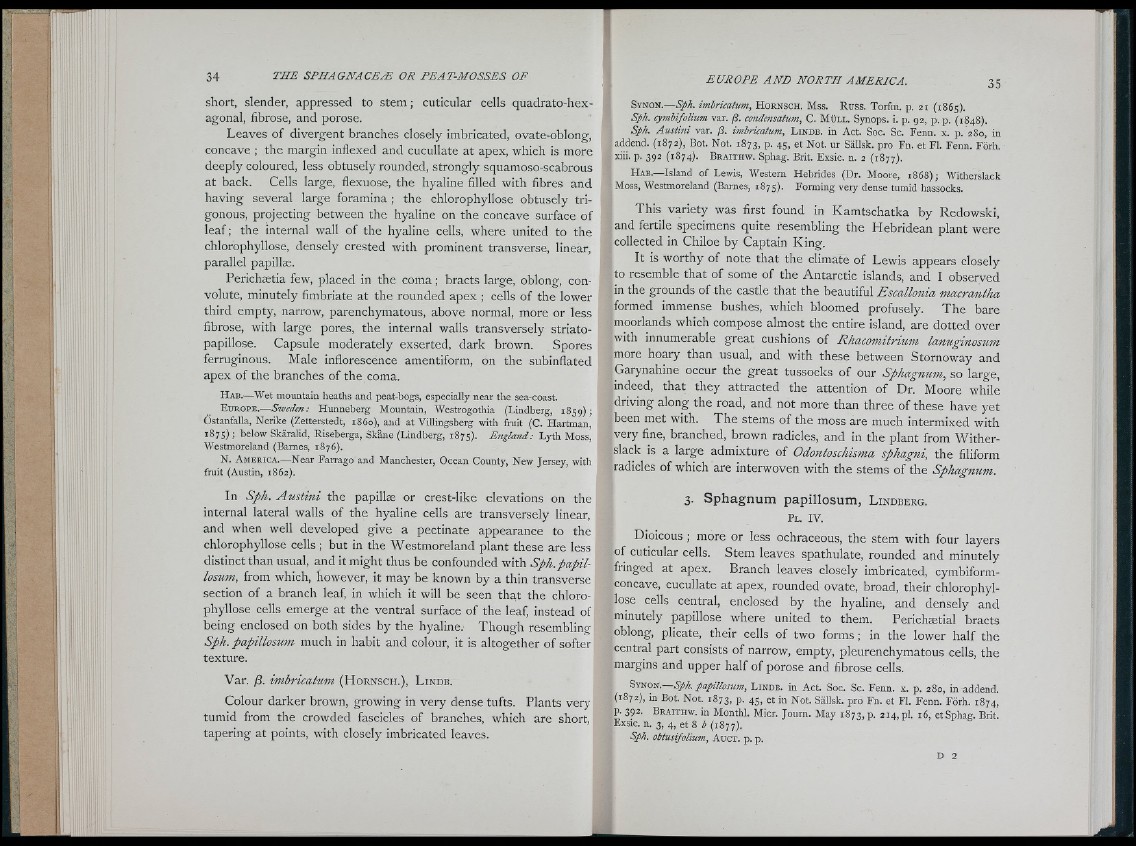
short, slender, appressed to s tem ; cuticular cells quadrato-hexagonal,
fibrose, and porose.
Leaves o f divergent branches closely imbricated, ovate-oblong,
concave ; the margin inflexed and cucullate at apex, which is more
deeply coloured, less obtusely rounded, strongly squamoso-scabrous
at back. Cells large, flexuose, the hyaline filled with fibres and
having several large foramina ; the chlorophyllose obtusely trigonous,
projecting between the hyaline on the concave surface o f
lea f; the internal wall of the hyaline cells, where united to the
chlorophyllose, densely crested with prominent transverse, linear,
parallel papillae.
Perichaetia few, placed in the coma; bracts large, oblong, convolute,
minutely fimbriate at the rounded apex ; cells o f the lower
third empty, narrow, parenchymatous, above normal, more or less
fibrose, with large pores, the internal walls transversely striato-
papillose. Capsule moderately exserted, dark brown. Spores
ferruginous. Male inflorescence amentiform, on the subinflated
apex o f the branches o f the coma.
H a b .—Wet mountain heaths and peat-bogs, especially near the sea-coast.
E u r o p e .— Sweden: Hunneberg Mountain, Westrogothia (Lindberg, 1859);
Ostanfalla, Nerike (Zetterstedt, i860), and at Villingsberg with fruit (C. Hartman,
1875); below Skaralid, Riseberga, Skane (Lindberg, 1875). England: Lyth Moss,
Westmoreland (Barnes, 1876).
N. A m e r i c a .— Near Farrago and Manchester, Ocean County, New Jersey, with
fruit (Austin, 1862).
In Sph. A u s tin i the papillae or crest-like elevations on the
internal lateral walls o f the hyaline cells are transversely linear,
and when well developed give a pectinate appearance to the
chlorophyllose c e lls ; but in the Westmoreland plant these are less
distinct than usual, and it might thus be confounded with Sph. papillosum,
from which, however, it may be known by a thin transverse
section o f a branch leaf, in which it will be seen that the chlorophyllose
cells emerge at the ventral surface o f the leaf, instead of
being enclosed on both sides by the hyaline. Thou gh resembling
Sph. papillosum much in habit and colour, it is altogether o f softer
texture.
Var. imbricatum (H ornsch.), L indb.
Colour darker brown, growing in v e ry dense tufts. Plants very
tumid from the crowded fascicles o f branches, which are short,
tapering at points, with closely imbricated leaves.
S y n o n .— Sph. imbricatum, H o r n s c h . M ss . R u s s . Torfm. p. 21 (1865).
Sph. cymbifolium var. /3. condensatum, C. M ü l l . Synops. i. p. 92, p. p. (1848).
Sph. Austini var. /3. imbricatum, L in d b . in Act. Soc. Sc. Fenn. x. p. 280, in
addend. (1872), Bot. Not. 1873, p. 45, et Not. ur Sallsk. pro Fn. et FI. Fenn. Forh.
xiii. p. 392 (1874). B r a i t h w . Sphag. Brit. Exsic. n. 2 (1877).
H a b .— Island of Lewis, Western Hebrides (Dr. Moore, i868); Witherslack
Moss, Westmoreland (Barnes, 1875). Forming very dense tumid hassocks.
This variety was first found in Kamtschatka b y Redowski,
and fertile specimens quite resembling the Hebridean plant were
collected in Chiloe by Captain King.
It is worthy o f note that the climate o f Lewis appears closely
to resemble that o f some o f the Antarctic islands, and I observed
in the grounds o f the castle that the beautiful Escallonia macrantha
formed immense bushes, which bloomed profusely. T h e bare
moorlands which compose almost the entire island, are dotted over
with innumerable great cushions o f Rhacomitrium lanuginosum
more hoary than usual, and with these between Stornoway and
Carynahine occur the great tussocks o f our Sphagnum, so large,
indeed, that they attracted the attention o f Dr. Moore while
driving along the road, and not more than three o f these have yet
been met with. T h e stems o f the moss are much intermixed with
very fine, branched, brown radicles, and in the plant from Witherslack
is a large admixture o f Odontoschisma sphagni, the filiform
radicles o f which are interwoven with the stems o f the Sphagnum.
3. Sphagnum papillosum, L in d b e rg .
Pl. IV.
Dioicous ; more or less ochraceous, the stem with four layers
of cuticular cells. Stem leaves spathulate, rounded and minutely
fringed at apex. Branch leaves closely imbricated, cymbiform-
concave, cucullate at apex, rounded ovate, broad, their chlorophyllose
cells central, enclosed by the hyaline, and densely and
minutely papillose where united to them. Perichætial bracts
oblong, plicate, their cells o f two forms ; in the lower half the
central part consists o f narrow, empty, pleurenchymatous cells, the
margins and upper half o f porose and fibrose cells.
S,-y-so:s.— Sph. papillosum, L in d b . in Act. Soc. Sc. Fenn. x. p. 280, in addend.
(1872), in Bot. Not. 1873, P- 4 5 , et in Not. Sallsk. pro Fn. et FI. Fenn. Forh, 1874,
p. 392. B r a i t h w . in Monthl. Micr. Journ. May 1873, p. 214, pl. 16, etSphag. Brit.
Exsic. n. 3, 4, et 8 ¿ (1877).
Sph. obtusifolium, A u c t . p . p .